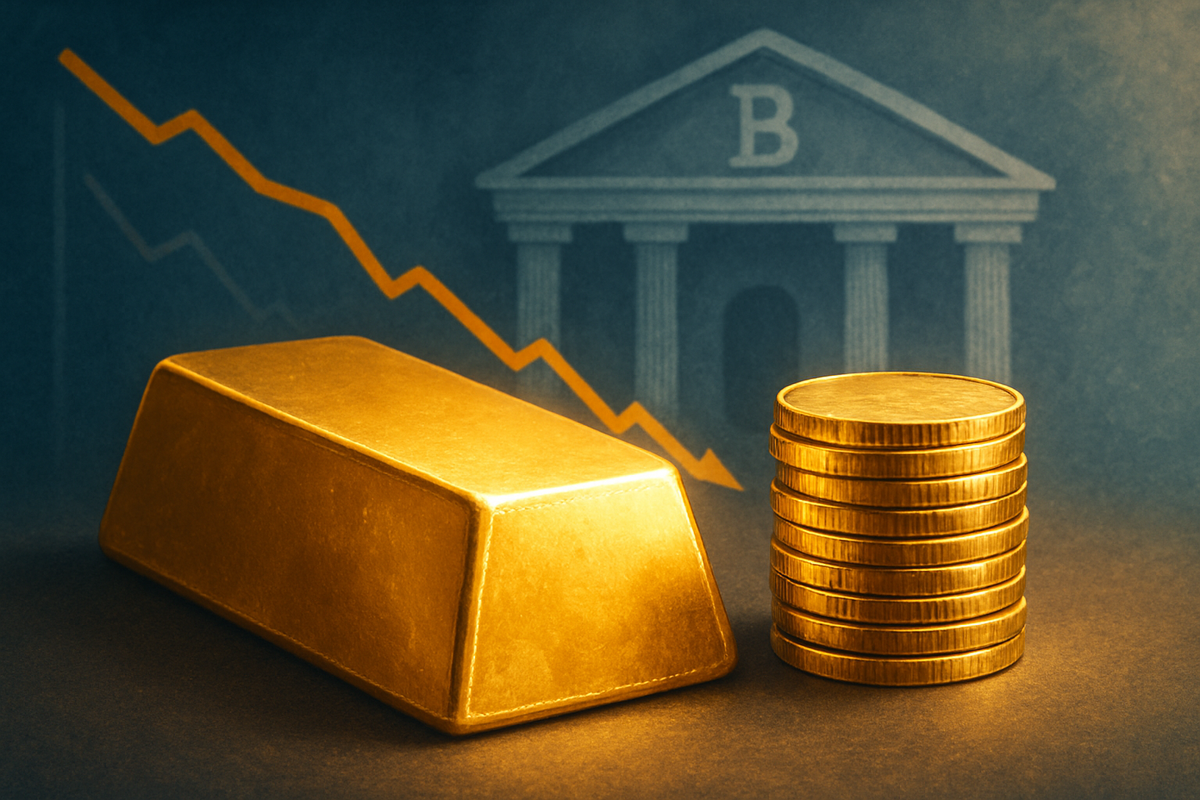
Gold prices have surged to unprecedented levels, driven by growing expectations of interest rate cuts from central banks worldwide, most notably the U.S. Federal Reserve. This bullish trend underscores the deeply rooted inverse relationship between interest rates and the value of the precious metal, as investors increasingly seek the safety and non-yielding appeal of gold in a shifting monetary landscape. The recent rally has seen gold breach significant psychological barriers, signaling a robust market momentum that analysts believe could continue into the foreseeable future.
The current environment, characterized by central banks pivoting towards more accommodative monetary policies, has created a highly favorable backdrop for gold. As the opportunity cost of holding non-yielding assets like gold diminishes with lower interest rates, and a weaker U.S. dollar makes gold more attractive to international buyers, the demand for bullion has escalated. This dynamic has propelled gold to record highs, solidifying its role as a crucial hedge against economic uncertainty and a key store of value.
Central Banks Signal Easing: A Catalyst for Gold's Ascent
The primary catalyst for gold's remarkable upward trajectory is the clear signal from major central banks that an era of interest rate tightening is giving way to a period of easing. This shift is largely a response to concerns over softening labor markets and persistent, albeit moderating, inflationary pressures, necessitating a less restrictive monetary stance. The U.S. Federal Reserve, a pivotal player in global financial markets, has been at the forefront of this policy pivot.
In September 2025, the Federal Reserve cut its policy interest rate by 0.25% to a range of 4.00%-4.25%, a move widely anticipated by market participants. This decision marked a significant turning point, with the Fed further projecting additional rate reductions for the remainder of 2025 and into 2026. J.P. Morgan Global Research, for example, anticipates two more cuts in 2025 and one in 2026, reinforcing market expectations for continued monetary loosening. Beyond the Fed, central banks globally are also reportedly increasing their gold reserves, viewing gold as an essential asset in an uncertain monetary environment and a hedge against escalating geopolitical and financial risks. This collective movement by central banks not only provides direct demand for gold but also signals a broader shift in monetary philosophy that favors non-yielding assets. The timeline of these events, culminating in the recent rate cut and future projections, has steadily built a strong bullish sentiment around gold throughout 2025.
Initial market reactions have been overwhelmingly positive for gold. The precious metal hit a record high of $3,896.49 per ounce on Thursday, October 2, 2025, and was trading around $3,861.04 on Friday, October 3, 2025. U.S. gold futures for December delivery also surged, reaching $3,884.30 per ounce. Gold has posted impressive gains, rising 9.52% over the past month and an astounding 46.44% compared to the same time last year. Bullion has gained 2.7% in the first week of October 2025 and has surged 47% year-to-date, demonstrating remarkable momentum and investor confidence in its continued appreciation.
Public Companies Poised to Win or Lose from Gold's Rally
The sustained rally in gold prices, fueled by anticipated interest rate cuts, creates a distinct set of winners and losers within the public company landscape. Gold mining companies are arguably the most direct beneficiaries, as higher gold prices directly translate into increased revenues and potentially wider profit margins. Companies such as Barrick Gold (NYSE: GOLD), Newmont Corporation (NYSE: NEM), and Agnico Eagle Mines (NYSE: AEM) stand to gain significantly. Their existing gold reserves become more valuable, and the economics of extracting gold from higher-cost mines improve, potentially leading to increased production and exploration activities. These companies often see their stock prices correlate strongly with gold's movements, and a prolonged bull market in gold could lead to substantial shareholder returns.
Conversely, companies heavily reliant on a strong U.S. dollar or those with significant exposure to interest-rate-sensitive sectors might face headwinds. While not directly losing from gold's rise, a weaker dollar—a common consequence of rate cuts—can impact import-heavy businesses or those with substantial overseas operations that become less profitable when converted back to a weaker home currency. Furthermore, financial institutions that thrive on higher interest rate differentials might see pressure on their net interest margins as rates decline. However, the overall market sentiment suggests that the positive impact on gold-related entities far outweighs the indirect negative pressures on other sectors, at least in the context of this specific gold rally.
Investment vehicles focused on gold, such as gold ETFs like SPDR Gold Shares (NYSE Arca: GLD) and iShares Gold Trust (NYSE Arca: IAU), also stand as clear winners. These funds provide investors with an accessible way to gain exposure to gold price movements without directly owning the physical metal. As gold prices climb, the net asset value of these ETFs increases, attracting more capital and further reinforcing the bullish trend. Companies involved in gold refining, trading, and jewelry manufacturing might also see increased activity, albeit with varying margins depending on their specific business models and hedging strategies. The overarching theme is that any entity with direct or indirect exposure to the price of gold is currently operating in a highly favorable market.
Broader Implications and Historical Parallels
The current gold rally, driven by central bank easing expectations, fits squarely into broader industry trends emphasizing diversification and risk mitigation in an uncertain global economy. This event highlights gold's enduring role as a safe-haven asset, particularly when traditional financial assets offer diminished returns or face increased volatility. The shift towards lower interest rates globally signals a potential period of slower economic growth or efforts to stimulate economies, making non-yielding assets like gold comparatively more attractive. This trend also reflects a growing skepticism among some investors about the long-term stability of fiat currencies, especially given the expansive monetary policies pursued by central banks over the past decade.
Potential ripple effects extend across various sectors. For instance, a sustained gold rally could draw investment away from other commodities or even certain equity sectors, as investors reallocate capital towards perceived safer havens. Competitors in the precious metals space, such as silver and platinum, often track gold's movements, albeit with higher volatility, suggesting they too could benefit from this sentiment. Regulatory or policy implications might arise if the gold market becomes excessively speculative, though current trends primarily reflect fundamental drivers. Historically, periods of significant monetary easing by central banks have often coincided with strong gold performance. For example, during the quantitative easing programs following the 2008 financial crisis, gold experienced a multi-year bull run as real interest rates dipped into negative territory. Similarly, during periods of geopolitical instability or economic uncertainty in the 1970s and early 2000s, gold served as a critical hedge, demonstrating its consistent appeal when conventional investments falter. These historical precedents provide a strong foundation for the current market's conviction in gold's upward trajectory.
Moreover, the increasing demand for gold from central banks themselves is a significant trend. This strategic accumulation by sovereign entities not only adds to the demand side of the equation but also signals a collective effort to diversify national reserves away from over-reliance on a single currency, such as the U.S. dollar. This institutional buying provides a strong floor for gold prices and underscores its perceived value as a global monetary asset, further solidifying its importance in the broader financial architecture.
What Comes Next: Navigating Gold's Future
Looking ahead, the short-term outlook for gold remains highly positive, largely contingent on the continued execution of anticipated interest rate cuts by central banks. Should the Federal Reserve and other major central banks proceed with the projected easing cycle, gold is likely to maintain its upward momentum, with some analysts even forecasting prices to breach the $4,000 per ounce mark by year-end. In the short term, any economic data that reinforces the need for rate cuts (e.g., weaker inflation, softer labor market reports) will likely provide further impetus for gold. Conversely, stronger-than-expected economic data or a hawkish shift in central bank rhetoric could introduce volatility and temper the rally.
In the long term, gold's trajectory will be influenced by a confluence of factors, including the global economic growth outlook, geopolitical stability, and the persistence of inflation. Should a prolonged period of low real interest rates become the norm, gold's appeal as a store of value will likely endure. Potential strategic pivots for investors include increasing exposure to physical gold, gold-backed ETFs, or shares of well-managed gold mining companies. Market opportunities may emerge in derivatives markets for those looking to hedge or speculate on gold price movements. Challenges could include unexpected shifts in monetary policy, a significant strengthening of the U.S. dollar, or a substantial reduction in geopolitical tensions, which could diminish gold's safe-haven appeal.
Potential scenarios and outcomes vary. A "soft landing" for the global economy, where inflation is tamed without a severe recession, might still see gold perform well if rates remain low. However, a "hard landing" or a deeper recession could ignite even stronger safe-haven demand, pushing gold to even greater heights. Conversely, a rapid and sustained global economic recovery with rising real interest rates could pose the most significant headwind for gold. Investors should closely monitor central bank communications, inflation data, and geopolitical developments to adapt their strategies accordingly.
Comprehensive Wrap-Up: Gold's Enduring Appeal
In summary, the current surge in gold prices is a direct reflection of growing expectations for interest rate cuts by central banks, particularly the U.S. Federal Reserve. The inverse relationship between interest rates and gold values is playing out prominently, making the non-yielding asset increasingly attractive as the opportunity cost of holding it diminishes. Gold has achieved record highs, demonstrating its robust appeal as a safe haven and a hedge against economic uncertainty, a role further bolstered by increased central bank gold purchases.
Moving forward, the market will remain highly sensitive to central bank guidance, inflation data, and broader economic indicators. Investors should assess their portfolios for appropriate exposure to gold, considering its historical resilience during periods of monetary easing and economic transition. The sustained rally has created significant opportunities for gold mining companies and gold-backed investment vehicles, while highlighting gold's enduring significance in a diversified investment strategy.
What investors should watch for in the coming months includes any adjustments to central bank rate cut timelines, inflation prints that deviate significantly from expectations, and shifts in geopolitical risk. The current environment strongly suggests that gold's luster is far from fading, positioning it as a key asset to monitor and potentially integrate into investment strategies as the global financial landscape continues to evolve.
This content is intended for informational purposes only and is not financial advice



